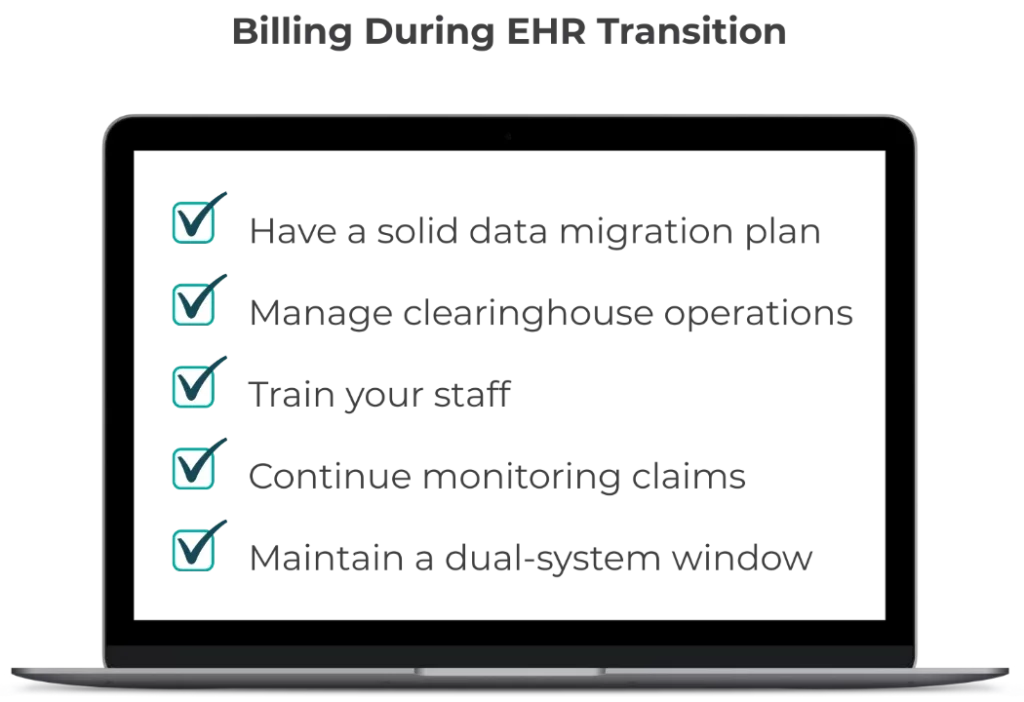Key Takeaways
- Accurate data migration prevents denied claims and payment delays.
- Clearinghouse transitions can cause cash flow disruptions if mishandled.
- Proper staff training reduces billing errors and ensures revenue continuity.
- Explore our dermatology-specific EHR features.
Upgrading dermatology EHR systems can be one of the most valuable moves your practice makes. The right system is a gamechanger. Modern tech designed for your specialty can streamline workflows, improve documentation, and support better patient care.
But here’s the challenge: without a well-planned transition, you can unintentionally create billing problems that slow down cash flow, increase claim denials, and put compliance at risk.
Much like setting up a new smartphone—if you forget to transfer your contacts, apps, and photos—you could find yourself scrambling. Only in healthcare, the stakes are higher. Missing billing data, payer enrollment issues, or unmonitored claims can directly impact your bottom line.
Whether you manage billing in-house or use a dermatology billing service, being aware of these common mistakes will help you protect your revenue during an EHR switch.
Table of Contents

Forgetting Data Migration and Validation Steps
One of the largest risks as you change a dermatology EHR system is failing to migrate billing data correctly. Missing or corrupted financial records can cause denials, delayed payments, and inaccurate patient balances. On top of issues with data, these mistakes are expensive. Studies show that nearly 38% of data migration projects go over budget or face significant delays due to errors, proving detailed planning is essential.
Practices often underestimate the amount of historical billing data to be transferred. This includes patient demographics, outstanding claims, insurance contracts, and financial reports. If this information is incomplete or inaccurate, reimbursement challenges can continue long after the new system is in place.
How to Avoid It
Work with an experienced dermatology EHR vendor to create a structured data migration plan. Before going live, verify all transferred billing data, test claim submissions, and cross-check financial reports for accuracy. Run a small number of claims through the new system before full implementation to help identify problems early.
Ignoring Clearinghouse Transitions
Switching to a new EHR system often requires a clearinghouse change. This shift affects how claims are submitted and processed. If payer enrollments aren’t updated, or if the clearinghouse doesn’t integrate correctly with your EHR, delays, rejections, and revenue disruptions can occur.
Clearinghouse changes can also impact ERA delivery and payment posting. If not managed properly, these issues lead to lost payments or more manual work for billing staff.
How to Avoid It
Notify payers of your upcoming system change well in advance and update all clearinghouse enrollment information. Work with your EHR vendor to ensure smooth integration between the clearinghouse and your dermatology billing workflows. Monitor early claim submissions closely, and have backup workflows in case of delays.
Insufficient Training for Derm Billing Staff
Even with a top-tier dermatology EHR system, poorly trained staff can make costly billing errors. A lack of familiarity with the platform can result in coding mistakes, missed modifiers, and incomplete claims—causing denials and slowing reimbursement. A study published in BMC Health Services Research found that patients can also experience frustration during EHR transitions, especially when staff lack adequate training.
Billing errors don’t only impact revenue. Incorrectly submitted claims can lead to audits or penalties, especially for services billed under strict payer documentation rules. EHR transitions are known to be disruptive, making thorough training essential.
How to Avoid It
Provide comprehensive training for your entire time, especially billing and administrative staff, before launch. Focus on hands-on practice, offer clear step-by-step guides, and set up a support channel for ongoing questions. Encourage continued education on dermatology billing compliance and claim resubmissions. Assign “super-users” who can help colleagues with troubleshooting as they adjust.
Failing to Monitor Claims When Switching EHRs
During an EHR switch, dermatology billing service teams often get caught up in implementation and overlook claim monitoring. This can lead to submission backlogs, unworked denials, and an increase in rejections.
Differences in system configurations can also cause shifts in reimbursement patterns. If left unaddressed, these changes can hurt cash flow and require extensive corrections.
How to Avoid It
Dedicate staff to track claims in both the old and new systems for at least the first few months. Run dual reports comparing pre- and post-migration claims data. Use analytics to flag discrepancies and ensure claims are processed efficiently. Create a workflow to review and respond to denials quickly, and set up alerts in the new system for rejected claims so they can be fixed and resubmitted without delay.
Skipping a Dual-System Window
Shutting down your old EHR too soon can create billing gaps and compliance risks. Without access to historical data, error troubleshooting becomes more difficult, and submitting accurate claims is harder.
A dual-system period allows your team to compare records, keep billing continuous, and identify missing data before committing fully to the new platform. Without overlap, small errors can escalate into major setbacks.
How to Avoid It
Plan to keep both systems active for 60–90 days after go-live. This gives staff time to cross-check billing data, follow up on pending claims, and adapt to new workflows without losing revenue. If possible, maintain access to historical billing data longer to support audits and reconciliation.
Experience a Smooth Transition
Switching dermatology EHR systems doesn’t have to disrupt your revenue cycle. Avoiding these five mistakes can help your practice maintain financial stability while transitioning to a system that better supports your specialty. With careful planning, thorough training, and consistent monitoring, you can protect your bottom line and maximize your EHR investment.











